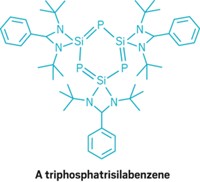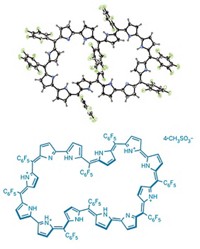Advertisement
Grab your lab coat. Let's get started
Welcome!
Welcome!
Create an account below to get 6 C&EN articles per month, receive newsletters and more - all free.
It seems this is your first time logging in online. Please enter the following information to continue.
As an ACS member you automatically get access to this site. All we need is few more details to create your reading experience.
Not you? Sign in with a different account.
Not you? Sign in with a different account.
ERROR 1
ERROR 1
ERROR 2
ERROR 2
ERROR 2
ERROR 2
ERROR 2
Password and Confirm password must match.
If you have an ACS member number, please enter it here so we can link this account to your membership. (optional)
ERROR 2
ACS values your privacy. By submitting your information, you are gaining access to C&EN and subscribing to our weekly newsletter. We use the information you provide to make your reading experience better, and we will never sell your data to third party members.
Synthesis
Tellurium twist on hypervalent electrophilic fluorination chemistry
Analogs of Togni’s iodine compounds could expand versatility and use of perfluoroalkyl transfer reagents
by Stephen K. Ritter
October 2, 2017
| A version of this story appeared in
Volume 95, Issue 39

Hypervalent iodine compounds are versatile reagents for transferring functional groups to organic molecules. For example, these compounds have become popular as electrophilic trifluoromethylating reagents. The fluorinating reagents, first reported in 2006 by Antonio Togni and his group at the Swiss Federal Institute of Technology (ETH), Zurich, take advantage of iodine(III)’s ability to maintain two lone pairs of electrons while bonding with a CF3 group and a phenyl ring and forming a stabilizing side ring through interactions with an adjacent oxygen or nitrogen phenyl substituent (one example shown). Since 2006, Togni and coworkers have made several modifications to the original compounds by way of changing the fluorinated and phenyl substituent groups. In the latest effort, Togni and Ewa Pietrasiak in his group have gone further to replace iodine itself with its periodic table neighbor tellurium (Organometallics 2017, DOI: 10.1021/acs.organomet.7b00535). Hypervalent compounds are those that contain a group 13 to 18 element bearing more than eight valence electrons. Because iodine(III) with 10 valence electrons fits that bill, Togni and Pietrasiak thought tellurium(II) compounds with a similar electronic structure might work as fluorinating reagents as well. The researchers made a series of fluorinated tellurium(II) compounds (shown), including ones with CF2H and C6F5 groups that aren’t known for the iodine reagents, and studied their hypervalent nature via structural and spectroscopic data. The team is now testing the tellurium derivatives for their ability to function as perfluoroalkyl transfer reagents.





Join the conversation
Contact the reporter
Submit a Letter to the Editor for publication
Engage with us on Twitter